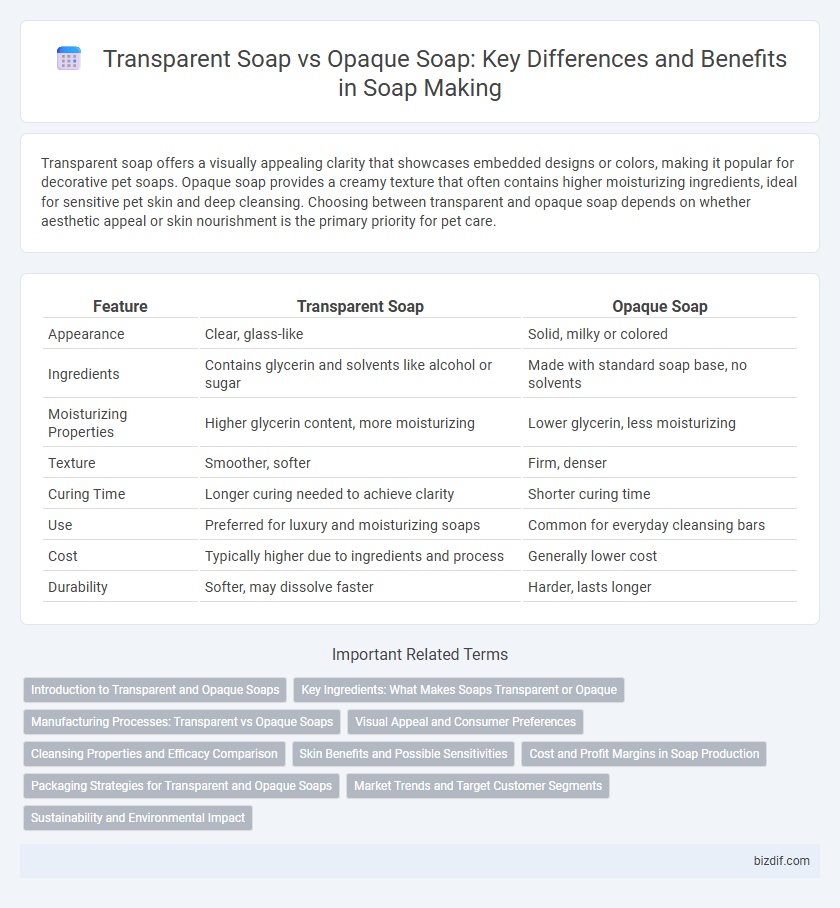Transparent soap offers a visually appealing clarity that showcases embedded designs or colors, making it popular for decorative pet soaps. Opaque soap provides a creamy texture that often contains higher moisturizing ingredients, ideal for sensitive pet skin and deep cleansing. Choosing between transparent and opaque soap depends on whether aesthetic appeal or skin nourishment is the primary priority for pet care.
Table of Comparison
| Feature | Transparent Soap | Opaque Soap |
|---|---|---|
| Appearance | Clear, glass-like | Solid, milky or colored |
| Ingredients | Contains glycerin and solvents like alcohol or sugar | Made with standard soap base, no solvents |
| Moisturizing Properties | Higher glycerin content, more moisturizing | Lower glycerin, less moisturizing |
| Texture | Smoother, softer | Firm, denser |
| Curing Time | Longer curing needed to achieve clarity | Shorter curing time |
| Use | Preferred for luxury and moisturizing soaps | Common for everyday cleansing bars |
| Cost | Typically higher due to ingredients and process | Generally lower cost |
| Durability | Softer, may dissolve faster | Harder, lasts longer |
Introduction to Transparent and Opaque Soaps
Transparent soap contains higher glycerin levels, which allow light to pass through, creating a clear or translucent appearance, while opaque soap typically contains fillers like titanium dioxide that scatter light, resulting in a solid, non-transparent look. The transparency of soap influences its aesthetic appeal and perceived purity, often associated with handcrafted or specialty formulations. Understanding the differences in ingredients and manufacturing processes helps in selecting the appropriate soap type for specific skincare needs and personal preferences.
Key Ingredients: What Makes Soaps Transparent or Opaque
Transparent soap contains higher amounts of glycerin, a humectant that retains moisture and dissolves oils, creating a clear, glass-like appearance. Opaque soap includes insoluble additives such as titanium dioxide or zinc oxide, which scatter light and give the bar a creamy, solid look. The balance of solvents, glycerin concentration, and the inclusion of opacifying agents directly influences the transparency or opacity of the final soap product.
Manufacturing Processes: Transparent vs Opaque Soaps
Transparent soap manufacturing involves using higher amounts of solvents like alcohol and sugar to dissolve oils and glycerin, resulting in a clear, glass-like appearance. Opaque soaps are produced through saponification with a higher concentration of solid fats and minimal solvents, creating a creamy, dense texture that scatters light. The distinct formulation and curing times in each process influence the soap's clarity, hardness, and moisturizing properties.
Visual Appeal and Consumer Preferences
Transparent soap offers a glossy, glass-like appearance that highlights embedded ingredients and appeals to consumers seeking a modern, artisanal look. Opaque soap, with its solid, creamy texture, conveys a traditional and comforting aesthetic favored by customers prioritizing classic and natural perceptions. Consumer preferences tend to vary based on the desire for visual clarity or a rich, milky finish, influencing purchasing decisions in the handmade soap market.
Cleansing Properties and Efficacy Comparison
Transparent soap typically contains higher glycerin content, providing a moisturizing effect while maintaining effective cleansing properties by dissolving oils and dirt efficiently. Opaque soap often includes fillers like talc or titanium dioxide, which can reduce cleansing potency but enhance exfoliation or skin protection benefits. Both types vary in efficacy depending on ingredient formulation, with transparent soaps offering gentler, hydrating cleanses and opaque soaps delivering stronger, sometimes more astringent cleaning performance.
Skin Benefits and Possible Sensitivities
Transparent soap contains higher glycerin levels and less harsh detergents, making it gentle and moisturizing for sensitive or dry skin. Opaque soap often includes added fats and fragrances, which can provide rich cleansing but might trigger irritation in sensitive skin types. Choosing transparent soap reduces the risk of allergic reactions and supports skin hydration more effectively.
Cost and Profit Margins in Soap Production
Transparent soap typically incurs higher production costs due to the use of specialty ingredients like glycerin and solvents, which contribute to its clarity and smooth texture. Opaque soap generally requires less expensive raw materials such as natural fats and lye, resulting in lower manufacturing expenses and higher profit margins. Soap producers often weigh these cost differences against market demand to optimize profitability in their product lines.
Packaging Strategies for Transparent and Opaque Soaps
Transparent soap benefits from minimalist, clear or frosted packaging that highlights its see-through quality and purity, often incorporating eco-friendly materials to appeal to conscious consumers. Opaque soap packaging allows for more vibrant, colorful designs that emphasize brand identity and scent profiles, enabling creative use of patterns and textures to attract attention on shelves. Strategic packaging for both soap types balances aesthetic appeal with protection from light and moisture to maintain product integrity and prolong shelf life.
Market Trends and Target Customer Segments
Transparent soap commands a premium segment due to its perceived purity and aesthetic appeal, attracting health-conscious and luxury market consumers. Opaque soap remains popular in mass markets because of its affordability and versatility, catering to budget-sensitive customers and commercial users. Market trends indicate growing demand for natural, transparent soaps among millennials and eco-conscious buyers, while opaque soaps maintain steady sales in traditional retail channels.
Sustainability and Environmental Impact
Transparent soap often requires the use of synthetic detergents and solvents, which can contribute to higher environmental pollution and resource depletion compared to opaque soap, typically made from natural oils and traditional saponification. Opaque soap's biodegradable ingredients and minimal chemical additives result in a lower ecological footprint, promoting sustainable practices in soap making. Choosing opaque soap supports eco-friendly production methods and reduces harmful impacts on aquatic ecosystems and soil quality.
Transparent Soap vs Opaque Soap Infographic

 bizdif.com
bizdif.com